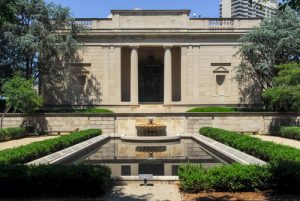Rodin Museum
Along the Benjamin Franklin Parkway in Philadelphia, PA stands an elegant attraction of Beaus-Arts architecture boasting a formal French garden. Since the parkway was designed to echo the Champs-Elyses in Paris, it is only right that one of the centerpieces of the area is a museum dedicated to a French national treasure: Auguste Rodin.
The Rodin Museum. A house of intellectuality and visual poetry. A collection of rare passion and history. An attraction worth visiting. 
A Little About Rodin
Francois Auguste Rene Rodin was a genius of French sculpture- arguably the founder of all modern sculpture- with a career spanning the late nineteenth and early twentieth centuries. Highly influenced by Italian sculpture, Rodin had a stereotypically bumpy road to success. He was traditionally trained as an artistic craftsman, but his visual style was not largely appreciated at the beginning of his career. He celebrated naturalism, tempestuous characterization, and raw physicality, while his contemporaries were lauded for their formulaic and decorative allegorical bent. However, history has crowned Rodin the decisive leader in his field. After all, he is responsible for one of the most globally recognizable works of art ever created: The Thinker.
A Brief History Of The Rodin Museum
It is wonderfully appropriate to have an art center in Philadelphia focusing on the work of this French sculptor. Rodin himself first sent eight of his masterpieces to the city in 1876, making it the location of his American debut.
The museum opened in November 1929 to immediate adoration. The building was imagined into existence by Paul Crew (a French architect) and Jacques Gréber (a French landscape designer), then gifted to the City of Philadelphia by the movie-theater mogul, Jules E. Mastbaum.
It has been renovated since then and from the very beginning has been managed by the Philadelphia Museum of Art. Today it boasts “nearly 150 bronzes, marbles and plasters” representing every single phase of the master’s career.
Things Not To Miss
The Thinker
Originally titled “The Poet,” this famous and fantastic work now synonymous with philosophy, sits outside considering the movings of the world near Logan Circle. Rodin designed it in the spirit of Dante in The Divine Comedy. But seeing it in person you can also pick up gestures of mythology’s Prometheus, the Bible’s Adam, and even Rodin himself. This exact statue is one of the original three castings of it made in Rodin’s lifetime.
The Burghers of Calais
It sits at the west entrance to the museum and is a testament to strength and sacrifice. The sculpture was commissioned by the town of Calais, exploring patriotic themes around the citizens who gave their lives to save everyone from the armies of King Edward III of England in medieval times.
The Gates of Hell
This is a special piece not just because of its significance as an allegorical wonder, but because it is the first bronze cast of the monument ever made. During Rodin’s lifetime, it only existed as a plaster cast that took almost forty years to create. He never developed the funds to see it cast in bronze in his lifetime. However, it still stands strong and passionate at the entrance to the museum. So you can’t miss it and you wouldn’t want to. It depicts scenes from Dante’s Inferno.
The Age of Bronze and Eve
These two beauties are posed overlooking the reflecting pool. Evocative of Rodin’s positive reaction to the works of Michelangelo and Donatello, each is life-sized and stunning in emotional, human proportion.
The Kiss
The concept for this piece originated as part of Rodin’s The Gates Of Hell, but it came to be so much more as an independent sculpture. Sure it’s erotic and passionately celebratory of the human body, but the power of it also exists in the dynamic of the couple. First, they are depicted as equals, as partners, which is somewhat revolutionary for the time it was created. Second, their lips are not touching, suggesting the highest point of tension never fully realized which is a bold moment to capture.
Eternal Springtime
A visceral depiction of love. You can certainly see between this work and The Kiss that he had a favorite female model during the time of this creation. The torso of Adle Abruzzezzi inspired the lines for both pieces.
Whatever you encounter, it’s always a pleasure to enjoy one of the best collections of Rodin sculptures outside of Paris.

